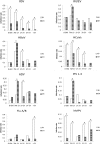Comparison of viral and epidemiological profiles of hospitalized children with severe acute respiratory infection in Beijing and Shanghai, China
- PMID: 31429710
- PMCID: PMC6701130
- DOI: 10.1186/s12879-019-4385-5
Comparison of viral and epidemiological profiles of hospitalized children with severe acute respiratory infection in Beijing and Shanghai, China
Abstract
Background: No comparison data have been reported on viral and epidemiological profiles of hospitalized children with severe acute respiratory infection (SARI) in Beijing or Shanghai, China.
Methods: We collected 700 nasopharyngeal aspirates (NPA) from hospitalized children with SARI in Beijing (northern China) and Shanghai (southern China). Multiple respiratory viruses (including 15 common viruses) were screened by validated polymerase chain reaction (PCR) or real-time reverse transcription-PCR assays and confirmed by sequencing. Demographic data and the distribution of viral infections were also examined.
Results: Of 700 samples, 547 (78.1%) tested positive for viral infections. The picornaviruses (PIC), which included rhinovirus (RV) and enterovirus (EV), were the most common (34.0%), followed by respiratory syncytial virus (RSV) (28.3%), human bocavirus (HBoV) (19.1%), adenovirus (ADV) (13.7%), human coronaviruses (HCoV) (10.7%), influenza A and B (8.9%), parainfluenza virus (PIV 1-3) (7.9%), and human metapneumovirus (HMPV) (5.0%). PIC (RV/EV) and RSV were the most prevalent etiological agents of SARI in both cities. The total and age-matched prevalence of RSV, HCoV, and hMPV among SARI children under 5 years old were significantly higher in Beijing than in Shanghai. Different age and seasonal distribution patterns of the viral infections were found between Beijing and Shanghai.
Conclusions: Viral infection was tested and shown to be the most prevalent etiological agent among children with SARI in either the Beijing or the Shanghai area, while showing different patterns of viral and epidemiological profiles. Our findings provide a better understanding of the roles of geographic location and climate in respiratory viral infections in hospitalized children with SARI.
Keywords: Beijing; Children; Epidemiological profile; Nasopharyngeal aspirates; Polymerase chain reaction; Severe acute respiratory infection; Shanghai; Virus.
Conflict of interest statement
The authors declare that they have no competing interests.
Figures


References
-
- World Health Organization . WHO global technical consultation: global standards and tools for influenza surveillance. Geneva: World Health Organization; 2011.
Publication types
MeSH terms
Grants and funding
- 2014ZX10004001-002/National Major Project for Control and Prevention of Infectious Disease in China
- 2017ZX10104001-002-003/National Major Project for Control and Prevention of Infectious Disease in China
- 2014ZX10004001-002/National Major Project for Control and Prevention of Infectious Disease in China
- (2016YFD0500301/National Key Research and Development Program of China
LinkOut - more resources
Full Text Sources

